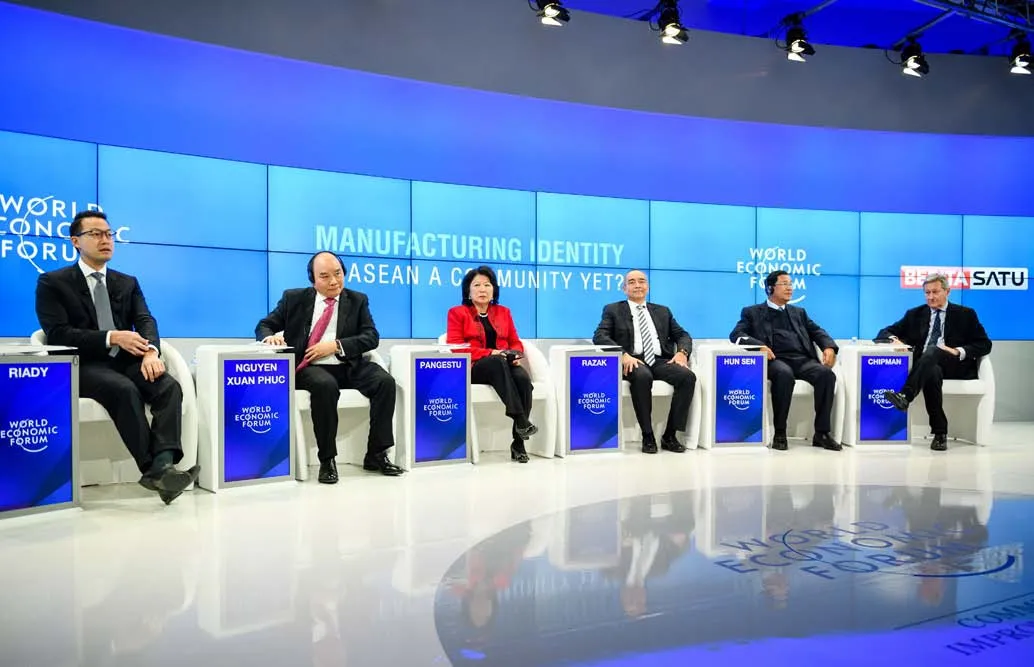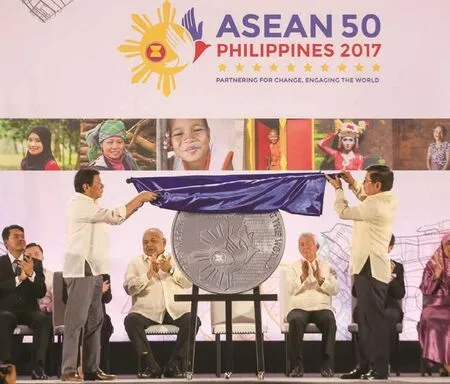东盟经济一体化:是时候“脚踏实地”了
2017-08-07安德鲁提利奥斯
□ 文/安德鲁·提利奥斯
东盟经济一体化:是时候“脚踏实地”了
□ 文/安德鲁·提利奥斯

2017年1月20日,越南总理阮春福、柬埔寨首相洪森共同出席“世界经济论坛2017年年会”分论坛,就东盟是否已建成“制造业共同体”,发表自己的意见和看法
悉数东盟的发展成就,可圈可点之处不少。自东盟于50年前成立以来,这一区域性集团的成员国数量,由最初的5个扩大到目前的10个。长期以来,东盟未曾受到地区间冲突的困扰,经济增长速度引人注目,呈现出一片和平、繁荣的发展景象。
1993年以来,东盟国家的贸易总额增加6倍多,由4000亿美元上升至2.5万亿美元。东盟各成员国的贫困水平降低,地区贫困人口或低收入人口占地区总人口(6亿)的比例越来越少。毫无疑问,东盟各成员国正逐渐看到:东盟各国的国民生活水平,由贫困行列向低收入行列、中等收入行列迈进。
在东盟国家中,新加坡是世界最富裕的国家之一;越南是世界经济增长速度最快的国家之一;而印度尼西亚、泰国、菲律宾和马来西亚的经济蓬勃发展,已正式进入中等收入国家行列。
为了实现东盟地区的繁荣与和平,东盟各国领导人共同制定了《东盟愿景2020》,旨在提高东盟的经济发展水平,加强域内国家间的贸易联系,实现东盟统一市场内的人员流动、商品流通、服务流通和资本流通等。
东盟经济一体化动力不足,域内国家贸易关系疏远
目前,东盟域内国家间的贸易关系并不牢靠。东盟国家(老挝除外)与域外国家之间的贸易额,仍是东盟域内国家之间的3倍。而在北美地区,《北美自由贸易协定》刚实施5年,其域内国家之间的贸易额就超过了域内国家与域外国家。
即使像新加坡这样经济高度开放的东盟国家,与其他东盟成员国之间的贸易额也不过才占其贸易总额的1/4而已;越南则忙于开拓国际市场,进展迅速。然而,东盟域内国家间的贸易额,仅占东盟贸易总额的13%。东盟设定了一系列政策性目标,其中一项便是加强东盟域内国家间的贸易联系。目前,这一目标还没有达成。
对于东盟国家而言,域内贸易的吸引力逊色于域外贸易。从某种程度上说,这就意味着,东盟国家之间的经济联系并没有得到加强。实际上,只有加强东盟域内国家间的经济联系,才能为东盟各国的企业提供发展动力,提升他们的国际竞争力。
贸易发展水平不高,意味着东盟国家的经济发展在更大程度上依赖于美国、中国等经济大国。只要东盟各国的决策者们各尽其职,降低关税壁垒、非关税壁垒,那么东盟地区各种市场力量就能大有作为,东盟域内国家间的贸易联系也会更加紧密。
人们普遍认为:东盟各国处在不同的发展阶段,因此需要采取贸易保护措施——这种观点是错误的。无论是低收入国家还是高收入国家,都可以且一定可以在发展贸易往来过程中受益。公司之间存在竞争,国家之间也存在竞争,这都是常有的事情。不过,竞争也未必是件坏事——竞争有时候能促进经济的发展。东盟区域内的贸易联系不够密切,这就意味着东盟错过了诸多发展机遇。
20世纪90年代,中国以迅雷不及掩耳之势,登上了世界经济舞台,刹那间成为风靡全球商界的“宠儿”:对外贸易蓬勃发展,外国直接投资以惊人的速度流入中国。中国建立了庞大的生产网络。按理来说,要是世界各国的投资者们把东盟看作是“单一经济体”,东盟也应该能够建立起像中国那样的生产网络。
随着中国的经济增长,劳动者们的工资水平得到提高,其国内生产成本也随之增加。大批迁移到中国的行业,正面临着新的发展契机——区域生产网络将会从中国东部沿海地区外迁。那么,这些行业将会往哪儿迁移呢?中国内陆地区,印度,还是东盟国家?东盟是一个开放、竞争、联合的区域性组织,在吸引新型产业项目方面,胜算很大。
为此,必须采取措施来建立“东盟经济共同体”——该倡议旨在通过整合各个东盟国家,把东盟打造成为一个“单一市场”,人们对此盼望已久。“单一市场”既可以平衡发展机遇,又可以对大国进行制衡。东盟作为“单一市场”,是一个影响力更为巨大的经济体:其出台的各项政策,对内更有利于东盟国家的发展,对外则更有利于东盟与中国、欧盟等世界其他各大经济体之间的谈判磋商。
从东盟最新一轮的会谈情况来看, 非但没有明显的打造“单一市场”的行动迹象,反而追求一堆关于一体化和合作的虚无缥缈的承诺。而媒体报道则似乎十分关注诸多安全问题。
令人感到遗憾的是,东盟经济一体化将何去何从,一直悬而未决。东盟领导人多次呼吁实现东盟经济一体化,但从东盟各国的具体行动来看,几乎没有进展。推进东盟经济一体化,有利于提振世界各国投资者们对东盟的信心,更好地服务于东盟的招商引资。
东盟潜力尚未发挥?
东盟领导人把“成立东盟经济共同体”描绘得太美好,令人印象深刻。然而,理想与现实差距不小。
东盟领导人常常提到东盟经济共同体所取得的成绩,这是因为东盟各成员国的发展势头的确不错。但是,东盟目前尚未充分发挥其自身的潜力。东盟的决策者们,疏于加强区域内各国之间的贸易联系、推动东盟各国之间联动发展,未能尽最大程度创造发展机遇。
事实上,对大多数东盟国家来说,其经济增长得益于一系列双边自由贸易协定、东盟域外国家的投资以及本国国内政策措施的支持。东盟还不是一个“统一市场”。由此,我们或许可以理解东盟经济一体化程度不高的现状了;这或许也能够说明为什么东盟经济一体化进程动力不足。
东盟的决策者们应当承认:东盟经济共同体,主要是为稳定东盟各成员国之间的关系提供一个平台。面对中国、印度等强劲的区域成员时,东盟经济共同体可以把东盟各成员国团结在一起。另外,他们还要重申,由于东盟各成员国之间存在着明显的社会、文化差异,东盟经济共同体倡导和平、鼓励相互了解。
“谋定而后动”
没有人期望东盟经济共同体在一夜之间出现;不过,如果东盟各大会议还是把主要精力放在讨论发展愿景和指导方针上,人们同样不会对东盟经济共同体抱有任何希望。
东盟经济共同体要实现东盟区域经济一体化、成为“区域全面经济伙伴关系”的先驱者,决策者们就得实事求是地引领、评价东盟经济一体化的发展。个别政客可以对东盟经济一体化的发展夸夸其谈。但是,一旦明确了发展目标、行动指南,东盟国家,更准确来说是东盟作为一个整体,就要言必信,行必果。
为此,东盟领导人要设定明确的发展指标,以衡量出东盟经济一体化、对外贸易和投资等方面的总体发展情况;采取有效措施促进东盟区域内的贸易发展,消除关税壁垒、非关税壁垒;实现东盟区域内跨境投资的自由化;让国有重点金融机构面向市场开放,参与更多竞争;打破中小企业在业务上的地域限制;完善基础设施,为东盟域内物流业的发展添砖加瓦等。
虽然这些目标,听起来有些远大,但只要东盟把目光放长远一点,并愿意为之努力,推进东盟经济一体化会水到渠成的。
今后,东盟领导人在讨论东盟经济一体化时,可以评估一下东盟经济共同体是否按照预期的方向发展。东盟领导人应该通过量化数据,为东盟所取得的成就正名,而不是非常笼统地发布各种经济总量报告。
“东盟首脑会议”一年举办两届。会议的筹办,代价不菲。为了加强协调配合、确保会议有序进行,需要调集大量的人力。为该会议的筹备四处奔走的工作人员不计其数,而东盟各国首脑也把他们仅有的一点宝贵时间,耗在了一次次的会议上。
鉴于东盟各国为每次会议所花费的精力、寄予的希望,东盟各国人民有理由要求会谈成果满足他们更多的期待。如果东盟想要认真推进东盟经济一体化,那么,落实具体工作细节的时候到了。
·许志亮 编译
·来源:新加坡《亚洲新闻台》官网
ASEAN has come a long way since the five foreign ministers from Indonesia, Malaysia,Philippines, Singapore, and Thailand came together in Bangkok in August 1967 to establish an organization that would promote economic and social cooperation. Since then, ASEAN has evolved from a loose and informal association into a Community of ten states encompassing political-security,economic, and socio-cultural pillars,and sharing an ASEAN identity. It has also weathered several challenges –the Third Indochina War in the 1970s,the Asian financial crisis in 1997-1998, and the outbreak of SARS in 2003, among others. ASEAN has demonstrated adaptability and longevity,and as it commemorates its 50thfounding anniversary in 2017, it is high time to reflect on its past achievements and its continuously evolving role in the world.
ASEAN’s key accomplishments
The first key success of ASEAN is the general absence of an armed conflict among the Member States. Many scholars believed this has been ASEAN’s biggest contribution to the region and the world despite the diversity of its political systems and cultures and the existence of bilateral tensions arising from historical enmities and unresolved territorial and maritime disputes. ASEAN has maintained peace by socializing its Member States into principles and norms such non-interference in internal affairs, respect for sovereignty, and renunciation of threat and use of force— all enshrined in the 1976 Treaty of Amity and Cooperation (TAC). These principles have been upheld through consultations, non-confrontation, and consensus-building, or what is known as the “ASEAN Way.”
While the persistence of bilateral tensions and the reluctance of Member States to avail of formal and informal dispute settlement mechanisms, such as the High Council and the ASEAN Troika, have been pointed out as evidence of ASEAN’s ineffectiveness,it can be argued that the regional organization has succeeded in defusing conflicts by urging restraint. ASEAN Member States have become concerned about jeopardizing their standing in the region, and thus have opted for restraint even when pursuing national objectives. Thus, despite not taking a mediating role, ASEAN has contributed to managing tensions through informal and non-legalistic means.
The absence of an armed conflict in Southeast Asia has led to the second key success of ASEAN which is its role in promoting national and regional economic development. ASEAN has contributed to “a regional and international political order that has promoted a climate for economic assistance, trade, and FDI supporting national development programs.” Its expansion of membership to include Laos, Myanmar, Cambodia, and Vietnam has facilitated their greater integration into the regional economy and has allowed their respective economies to catch up. The establishment of an ASEAN Economic Community with its commitment to a free flow of goods,services, and mobility of people has also made the regional bloc more competitive and resilient amid a slowdown in the global economy and trade.
The third achievement of ASEAN has been its role in facilitating regional dialogue and cooperation in the broader Asia-Pacific region. ASEAN, as a group of small and middle-sized states,has engaged all major powers and has sought to become a driving force – or the concept of ASEAN Centrality –toward an inclusive and rules-based regional architecture. It has initiated different bilateral and multilateral mechanisms including the Dialogue Partnerships, the ASEAN Plus Three, the ASEAN Regional Forum (ARF), East Asia Summit (EAS), and the ASEAN Defense Ministers’ Meeting Plus(ADMM Plus). These platforms cover issues ranging from traditional security,economy and trade, and functional areas,mainly through confidence-building and dialogue.
ASEAN has also encouraged external powers to abide by the same principles and norms in the TAC as the foundation for inter-state relations in the region;accession to the TAC is, in fact, a requirement for a country to become an ASEAN Dialogue Partner. While ASEAN in its early years had declared neutrality and attempted to isolate itself from major power competition, it has come to acknowledge that engagement with and cooperation by major powers are critical to the maintenance of regional security.
Challenges ahead
While ASEAN has successfully adapted to regional developments over the past decades, there are current challenges that may necessitate an even more proactive and responsive association.
The first challenge is the changing regional security environment. As ASEAN marks its 50thyear, significantprogress in this regard would be a demonstration of its commitment to and leadership in managing the longstanding disputes.
The second challenge to ASEAN is responding to non-traditional and transnational security concerns ranging from disasters, climate change, violent extremism, maritime piracy, trade in illegal drugs, public health emergencies,and refugee flows. While ASEAN over the years has set up mechanisms and sectoral bodies to coordinate policies and promote cooperation, responses have been either belated or limited due to the emphasis on non-interference and consensus-based decision making. Efforts also vary from one ASEAN Member State to another as manifested by the gaps between regional commitments and complementing national policies. Compounding this shortcoming is the lack of a regional mechanism to enforce the implementation of regional commitments at the national level. As the impact of these security concerns crosses national borders, it becomes imperative that the ASEAN Member States become more proactive in assisting each other to deal with these challenges. This includes reassessing approaches that may have been successful in preserving ASEAN in the past but have been less effective in dealing with new security challenges.
The third challenge to ASEAN relates to the unresolved tensions between and among the Member States. While ASEAN has kept its members together by not bringing up sensitive issues, it has been incapacitated or even rendered irrelevant whenever a diplomatic crisis or a skirmish breaks out. As ASEAN consolidates its community-building process and fosters a regional identity,Member States should seek progress in addressing bilateral tensions to deepen mutual trust and confidence. While many of these problems cannot be easily overcome, Member States should actively explore diplomatic, rulesbased, and lasting solutions to these,including through means provided for by the TAC, the ASEAN Charter, and international law.

President Rodrigo Duterte and Bangko Sentral ng Pilipinas Governor Amando Tetangco Jr unveil the ASEAN 2017 commemorative coin on January 15, 2017.
Looking ahead to the next 50 years
Despite its criticisms and inadequacies,ASEAN has established itself as an important contributor to regional and international peace and stability in the past half century. ASEAN is a product of its own history and circumstances,and as it has demonstrated several times, it can evolve and adapt when the time calls for it. However, this does not mean that ASEAN should remain passive and reactive, and instead should challenge itself to grow. In the words of former Secretary-General Surin Pitsuwan, ASEAN “should not rest on its laurels” and should “adjust and keep up with the global trend.”
In the ASEAN Vision 2025, ASEAN envisages itself as “an outward-looking region” that is “cohesive, responsive and relevant in addressing challenges to regional peace and security” and with“a central role in shaping the regional architecture.” Realizing this vision entails a dual task of ensuring ASEAN unity and credibility as a regional and global player and promoting the continued development of each Member State toward resilience. ASEAN is only as strong as its weakest member, and therefore each Member State should strive for both collective and individual resilience. The succeeding 50 years will be measured not by the number of new declarations, vision statements,and blueprints, but by how ASEAN has thrived in responding to regional and global developments.
Louie Dane C. Merced is a Senior Foreign Affairs Research Specialist with the Center for International Relations and Strategic Studies of the Foreign Service Institute. This article was published by the Foreign Service Institute (FSI).
· Source: www.eurasiareview.com
Reflecting on ASEAN’s Contributions to Region and World
By Louie Dane C. Merced
